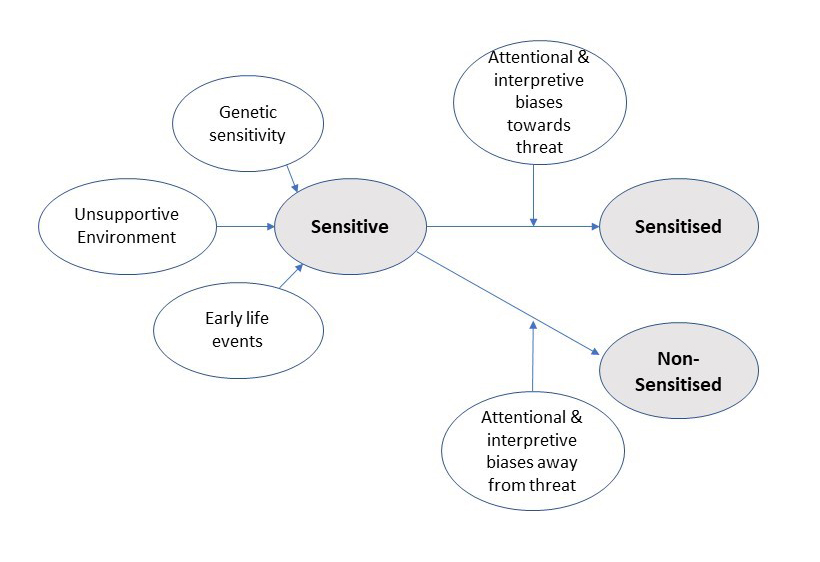The following blog will discuss the difference between ‘sensitivity’ and ‘sensitization’ and how this might relate to central sensitization pain.
Sensitivityto sensory stimuli is described in terms of neurological thresholds (Brown et al., 2001) were lower neurological thresholds for sensory stimulation relate to higher sensitivity. Sensory stimulation may include afferent input from sensors registering internal (e.g. muscle spindles, Golgi tendon organs, capsular and ligamentous mechanoreceptors, vestibular apparatus) or external (e.g. visual, auditory, gustatory, olfactory, tactile) sensory stimuli and emotion-related stimuli (Aron and Aron, 1997). Sensory sensitivity is said to be partly related to genetic background (Eysenck, 1997; Diatchenko et al., 2005; Aron and Aron, 1997). General sensory processing sensitivity is said to also be enhanced by early life circumstances and including the lack of a supportive environment (Pluess, 2015). Sensory processing sensitivity in clinical environments may be regarded as a disadvantageous character trait when it is linked to pain sensitivity and poor outcomes due to a tendency for sensory sensitive individuals to become easily overstimulated (Acevedo et al., 2018). However, sensory processing sensitivity is regarded as an advantageous personality trait by some authors because of the benefits of greater empathy to others’ affective cues, cognitive awareness of subtleties, greater depth of processing in a highly sensitive person (Acevedo et al., 2018; Aron and Aron, 1997). It is estimated that approximately 20-31% of healthy populations are highly sensitive (Aron and Aron, 1997; Lionetti et al., 2018).
Sensitization(in psychological terms) is a process by which an individual becomes susceptible to specific, previously insignificant stimuli. Sensitization appears to be associated with vigilance towards, interpretation of and behavioural responses to particular stimuli which are associated with a threatening source, even if the interpretation of the source is incorrect (Esteve and Camacho, 2008). Individuals with high trait anxiety are more prone to attentional and interpretational biases for threat (Eysenck, 1997). It is proposed that when stimuli and bodily sensations are intensified through attentional and interpretational bias for threat then the individual may become sensitised towards those sensations. It is already known that central sensitization is characterised by the perception of stimuli, which are normally non-noxious, as painful (Nijs et al., 2014). It is proposed that pre-morbid traits of sensory processing sensitivity and trait anxiety may play a key role in the aetiology of central sensitization. Conversely, trait anxiety-related personality traits possessing cognitive biases which show attention and interpretation away from threat (Eysenck and Derakshan, 2011) may be less likely to become sensitised (figure 1).

Figure 1: illustration of the proposed difference between sensory processing sensitivity and sensitization whereby sensitivity is an apparent trait in 20-31% of healthy populations but sensitization occurs when attentional and interpretation bias towards threat is added.
Jacqui Clark
2018 Pain in Motion
References and further reading:
Acevedo, B., Aron, E., Pospos, S. and Jessen, D. (2018) 'The functional highly sensitive brain: a review of the brain circuits underlying sensory processing sensitivity and seemingly related disorders.' Philosophical Transactions of the Royal Society B: Biological Sciences, 373(1744), 02/2612/05/accepted, p. 20170161.
https://www.ncbi.nlm.nih.gov/pubmed/29483346
Aron and Aron. (1997) 'Sensory processing Sensitivity and its Relation to Introversion and Emotionality.' Journal of Personality and Social Psychology, 73(2) pp. 345-368.
https://www.ncbi.nlm.nih.gov/pubmed/9248053
Brown, C., Tollefson, N., Dunn, W., Cromwell, R. and Filion, D. (2001) 'The Adult Sensory Profile: Measuring Patterns of Sensory Processing.' American Journal of Occupational Therapy, 55(1) pp. 75-82.
https://www.ncbi.nlm.nih.gov/pubmed/11216370
Diatchenko, L., Slade, G. D., Nackley, A. G., Bhalang, K., Sigurdsson, A., Belfer, I., Goldman, D., Xu, K., Shabalina, S. A., Shagin, D., Max, M. B., Makarov, S. S. and Maixner, W. (2005) 'Genetic basis for individual variations in pain perception and the development of a chronic pain condition.' Human Molecular Genetics, 14(1) pp. 135-143.
https://www.ncbi.nlm.nih.gov/pubmed/15537663
Eysenck. (1997) Anxiety and Cognition. A Unified Theory. Hove UK: Psychology Press.
Eysenck, M. W. and Derakshan, N. (2011) 'New perspectives in attentional control theory.' Personality and Individual Differences, 50(7), 5//, pp. 955-960.
http://isiarticles.com/bundles/Article/pre/pdf/38664.pdf
Lionetti, F., Aron, A., Aron, E. N., Burns, G. L., Jagiellowicz, J. and Pluess, M. (2018) 'Dandelions, tulips and orchids: evidence for the existence of low-sensitive, medium-sensitive and high-sensitive individuals.' Translational Psychiatry, 8(1), 2018/01/22, p. 24.
https://www.ncbi.nlm.nih.gov/pubmed/29353876
Nijs, J., Torres-Cueco, R., van Wilgen, P., Lluch Girbés, E., Struyf, F., Roussel, N., Van Oosterwijck, J., Daenen, L., Kuppens, K. and Vanderweeën, L. (2014) 'Applying modern pain neuroscience in clinical practice: criteria for the classification of central sensitization pain.' Pain physician, 17(5) pp. 447-457.
https://www.ncbi.nlm.nih.gov/pubmed/25247901
Pluess, M. (2015) 'Individual Differences in Environmental Sensitivity.' Child Development Perspectives, 9(3) pp. 138-143.
Rosa Esteve, M. and Camacho, L. (2008) 'Anxiety sensitivity, body vigilance and fear of pain.' Behaviour Research and Therapy, 46(6), 6//, pp. 715-727.